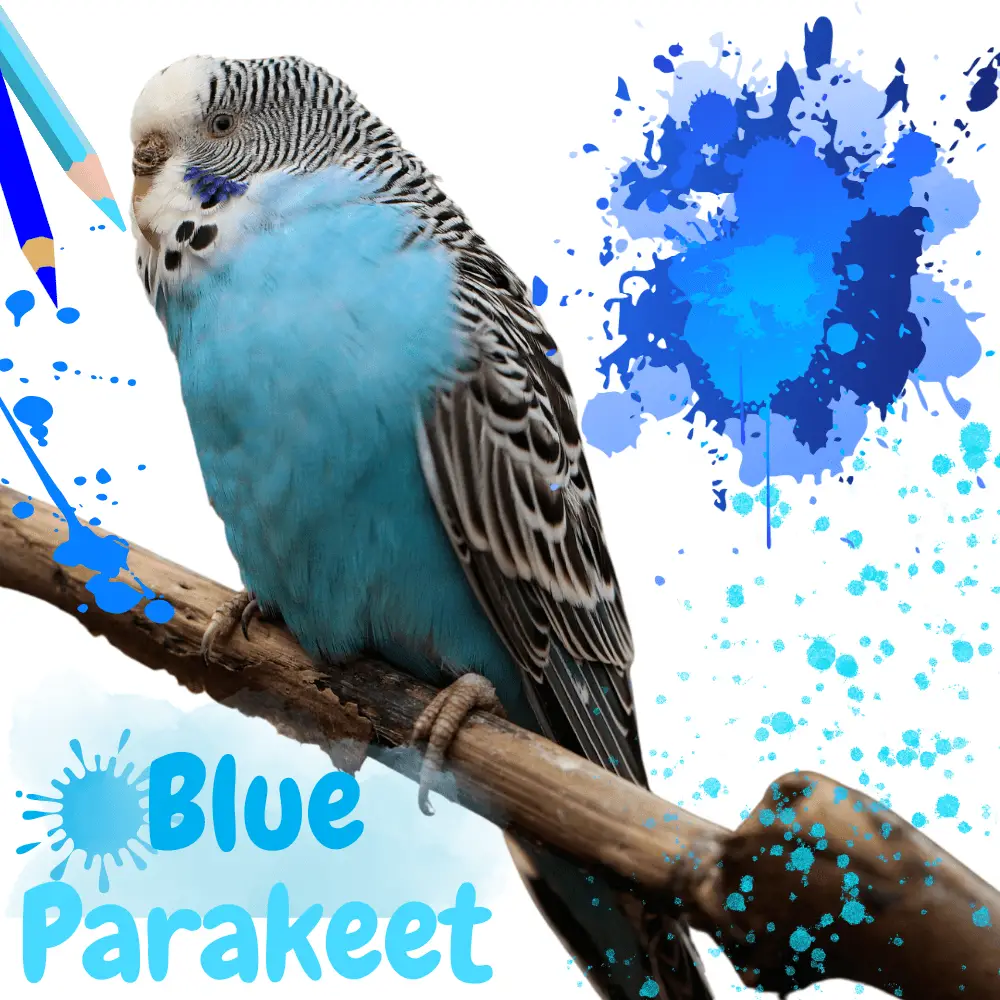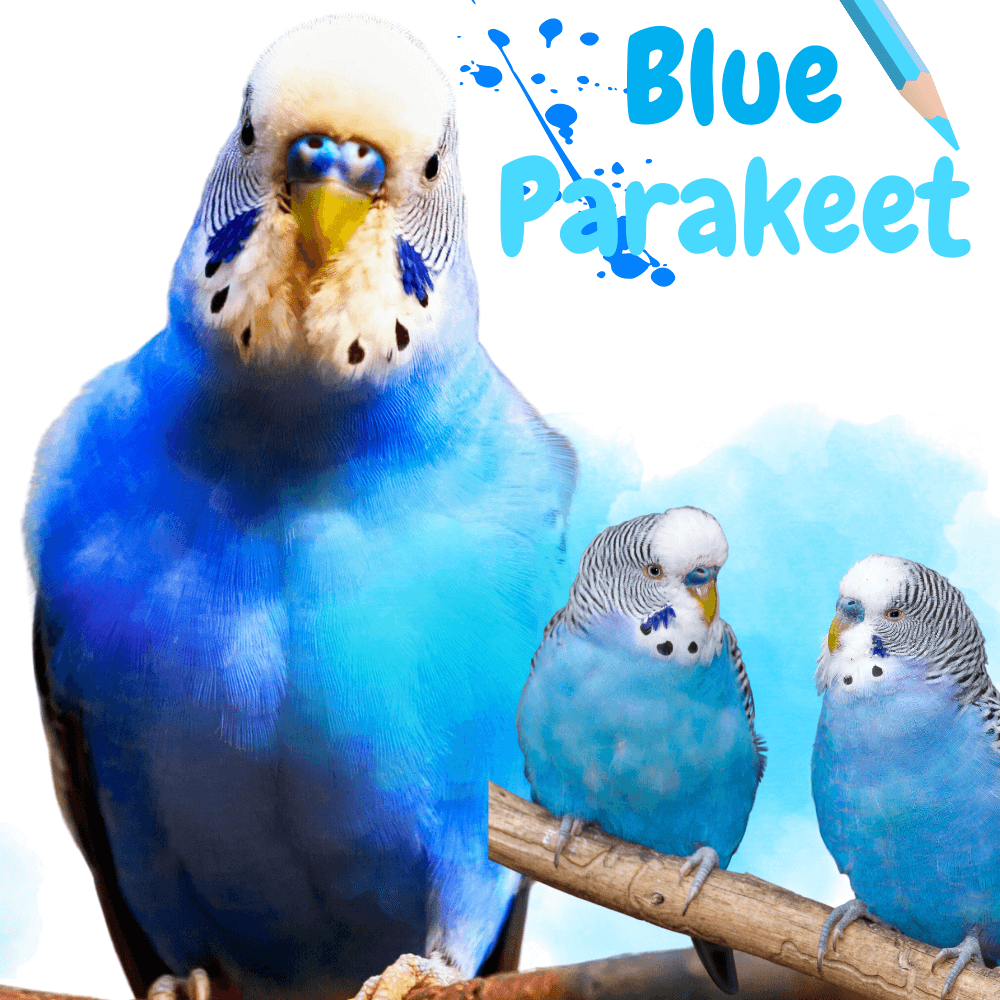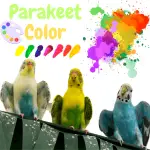
The blue parakeet mutation: The blue mutation characterizes birds whose body is light blue and the front of the head, called a “mask”, white. This mutation only concerns the color but not the ripples because the production of melanin is identical to that of the wild parakeet.
This mutation makes the yellow disappear, hence the green that turns blue on the body and the mask that changes from yellow to white. It is a recessive mutation that requires both parents to be carriers of the blue gene to obtain blue young.
If we do not know the genotype of a green mutation bird, by mating a green bird to a bluebird, you will have young carriers of the blue mutation that will be expressed to the next generation, or, if green was “blue carrier”, you will get young blue and green “blue carrier”.
Formation of plumage colours in budgerigars
Budgerigars are no longer only found in green-yellow but in many different budgie colors and Drawings. Even if the appearance of the vast majority of Shaft holders plays a subordinate role, many are curious as to which color their birds can be assigned. A look at our color dictionary helps. But How Do the different plumage colors actually arise?
Simply put, inside the spring there is a dye responsible for yellowing, as well as two other, dark dyes, which on the one hand for the Wave drawing, and on the other hand for blue coloring are (jointly) responsible. If a budgerigar owns both Dyes, it is colored green, lacks one of both dyes, it becomes yellow or blue – both are missing, so it is a white budgie.
At Schecken the dyes fall only in certain areas of the Feathers. In the case of plumage coloration, however, still, play other factors such as the structure of the spring play a role. Who it is would like to know more, is cordially invited to a little Biology (and a tiny bit of physics):
Dyes in plumage
In all animals – and also in humans – plumage, coat, or skin color are caused by small, roundish, or rod-shaped paint particles in the tissue, which are thus pigments. In budgerigars, three different Dyes play a role: psittacine, eumelanin, and Pheomelanin.
Melanins are found in many animal species and also in humans again, for example in our hair: While Eumelanin is brown or black colored, pheomelanin is for Blond or red coloration responsible. Melanins can both in the outer, so-called bark layer, as well as are also stored in the spring core, they are then referred to as Foreground or background melamine.
It is always only one of the two Melanins present in tissues – usually eumelanin. Only by a mutation that occurs in the color stroke of the folds, Eumelanin is replaced by pheomelanin.
Psittacine, on the other hand, is reserved for parrots in the animal kingdom – the family of parrots is used in Latin by the way, referred to as “Psittacidae”. Psittacine is yellowish in budgerigars and is also used as a fat dye – because it is soluble in fat and Fat droplets from the feather follicles into the newly growing feathers are transported. This dye is only present in the Bark layer, the outermost layer, embedded.
Blue parakeet

The wave drawing
For the wavy drawing of the parakeets, the above Eumelanin or Eumelanin is responsible for the foreground melanin. Pheomelanin is present in the outer layer of the bark embedded, whereby the plumage surface is dark colored and shows the typical wave patterns.
In a wild-colored budgerigar, eumelanin is in high Concentration present – the bird has a black Wave drawing. In birds in which eumelanin is lower If the quantity is stored, the drawing is lighter: the Intensity can vary from grey (as in the wave drawing of the Light and grey wings) to brown (in cinnamon).
Due to mutation, eumelanin in some parakeets is replaced by Pheomelanin replaced. This dye is more likely to be brown or yellowish and causes a lightened, slightly reddish Wave drawing: One speaks of fall.
Yellow, blue, and green or white parakeet?
That dark melanin causes the dark wave pattern is obvious. But how can black or black brown and yellow dyes blue and green plumage colors produce? For this, we need the promised physics! They are in the construction of the quill tree, especially in the tubular cavities, even the colorless structural cell layer.
When light hits the spring, it penetrates through the two outer layers in the spring core and is here on the stored (background) melanin, i.e. thrown back. The light waves interfere (overlap and partially extinguish) in the Structural cell layer, causing blue light to turn white light into Light is created.
The blue coloration is thus caused by the Interaction of the dark spring core and interference in the Structural cell layer! If now additionally in the Bark layer yellow psittacine is present, arises from blue and yellow-green as a perceived plumage color. If, in the case of a Bird no psittacine is stored, let’s just take the Blue coloration true.
If the melanin is missing in the nucleus, the light becomes and therefore, of course, cannot be reflected in the Structural cell layer and can be converted into blue light – only the yellow light from psittacine is perceived and the wave appears yellow.
When both psittacine and background melanin is absent, the feather knows, since neither psittacine Yellowing is still due to the reflection at the core Blue discoloration may develop. If pigments are present in the spring core are stored, but in lower concentrations, the bird is lightened or, if psittacine is still stored, yellow with a slight green tinge.
If a budgerigar lacks melanin not only in the Spring core, but in the entire body, so one speaks of a lutino, if psittacine is still present and the bird, therefore, is yellow, or from an albino, if all Color pigments are absent and the bird is pure white.
Since it also the foreground melanin is missing, these color strokes have no wave drawing. Have real “Inos” also always red eyes, because melanins do not stain only the feathers, but also the eyes dark.
Blue parakeet

The grey Wellis?
These birds have (such as cockatiels) no normally constructed structural cell layer in which the light The cavities of this layer are shrunk so much that instead they only have a is a too thin layer for interference. The Waves cannot take the necessary path in this layer.
which causes the interference to arise and thus leads to could lead to a green or blue color – Areas in which no psittacine is stored are therefore not blue, but gray (the dark color is determined by the keratinized structural cell layer slightly weakened), or, even if there is no melanin in the spring core, white.
The purple Wellis?
A “violet factor” is a mutation of the Structural cell layer, in which their structure changes in such a way The light interference is now violet instead of blue light. can be created.
This change in the Structural cell layer can be divided into different color strokes In addition to the absence of the different color pigments that may occur: psittacine-carrying Parakeets are colored in darker green than when they would have a “normal” structural cell layer, Albinos without dye get a slight pink tinge; but only parakeets that have melanin, but no psittacine (i.e. would normally be blue) become purple.
Light, dark, double dark?
The so-called “dark factor” is also caused by Changes in the structural cell layer. Is this thinner, the bird looks darker – with a dark factor results in a dark green and in two (double factor) an olive-green bird – or, in psittacinless birds from the blue row, dark blue and mauve. With “simple” and “double” means that this property is inherited by only one parent or by both parents.
In the case of spotted budgerigars, some areas of the Plumage are psittacine or melanin, while others are available. Thus, in the wild form and in the Yellow-faced from the blue row the yellow face – or in the numerous breeds the most diverse cheques on the whole body.
Also, the foreground melanin in the Bark layer can precipitate in partial areas or in less Concentration is present: This results in the brighter wave pattern in the Neck of Opalin birds. In Spangle’s budgerigars, the melanin “shifts” into the feather edges: The normally dark areas of the wave drawing are light and lined with darker edges.
Blue parakeet

Only for budgerigars
Also plays the property of psittacine, UV light to reflect, role. This “color” is for us imperceptible, is for budgerigars who perceive a different wavelength range of sunlight can be more important than us, but important when choosing a partner. From there you should give your birds the daylight spectrum of a bird lamp so that they can see each other in full color and can be admired.
Red budgerigars?
No matter how hard breeders try: Red Budgerigars will probably never produce them. Although the Coloration in red parrot species is also by psittacine, the but in a different (namely reddish) form must be present. Budgerigars, on the other hand, have only yellow Psittacine, so their plumage can never turn red – it simply lacks the necessary Pigments!
Also about the diet, it is not possible to color the plumage red, since budgerigars Carotene from food, which, for example, flamingos in the correct feeding turn pink, although by the parakeets but cannot be stored in the springs. Pictures of allegedly red budgerigars are a mistake.




















